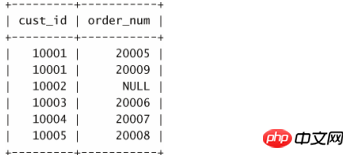
Natural Join
Whenever you join tables, there should be at least one column that appears in more than one table (the joined column). A standard join (the inner join introduced in the previous chapter) returns all data, even if the same column appears multiple times. Natural joins exclude multiple occurrences so that each column is returned only once.
How to complete this work? The answer is, the system doesn't do the job, you do it yourself. A natural join is a join in which you can select only those unique columns. This is typically done by using wildcards ( SELECT * ) for one table and explicit subsets for all other tables' columns. Here is an example:
Input:
select c.*,o.order_num,o.order_date,oi.prod_id,oi.quantity,oi.item_price from customers as c,orders as o,orderitems as oi where c.cust_id = o,cust_id and oi.order_num = o.order_num and prod_id = 'FB';
Analysis: In this example, wildcards are only used for the first table. All other columns are listed explicitly so no duplicate columns are retrieved.
In fact, every internal connection we have made so far has been a natural connection, and it is likely that we will never use an internal connection that is not a natural connection.
Outer Join
Many joins connect rows from one table to rows from another table Associated. But sometimes it is necessary to include rows that have no related rows. For example, you may need to use joins to complete the following tasks:
1. Count how many orders each customer has placed, including those who have not placed an order so far;
2. List all Products and order quantities, including products that no one has ordered;
3. Calculate the average sales size, including those customers who have not yet placed an order.
In the above example, the join contains rows that do not have related rows in the related tables. This type of join is called an external join.
The following SELECT statement gives a simple inner join. It retrieves all customers and their orders:
Input:
select customers.cust_id,orders.order_num from customers inner join orders on customers.cust_id = orders.cust_id;
Output:

Analysis: Similar to the internal join seen in the previous chapter, this SELECT statement uses the keyword OUTER JOIN to specify the type of join (instead of in the WHERE sub- specified in the sentence). However, unlike an inner join that relates rows from two tables, an outer join also includes rows that have no related rows. When using the OUTER JOIN syntax, you must use the RIGHT or LEFT keyword to specify the table that contains all its rows (RIGHT refers to the table on the right side of the OUTER JOIN, and LEFT refers to the table on the left side of the OUTER JOIN). The above example uses LEFT OUTER JOIN to select all rows from the left table (customers table) of the FROM clause. In order to select all rows from the right table, you should use RIGHT OUTER JOIN as shown in the following example:
Input:
select customers.cust_id,orders.order_num from customers right outer join orders on orders.cust_id = customers.cust_id;
No *= operator:MySQL No Supports the use of the simplified characters *= and =*, which are popular operators in other DBMSs.
Types of external joins:There are two basic forms of external joins: left external join and right external join. The only difference between them is the order of the associated tables. In other words, a left outer join can be converted into a right outer join by reversing the order of the tables in the FROM or WHERE clause. Therefore, both types of external joins can be used interchangeably, and which one to use is purely a matter of convenience.
The above is the detailed content of mysql advanced join-natural join, external join usage examples. For more information, please follow other related articles on the PHP Chinese website!




